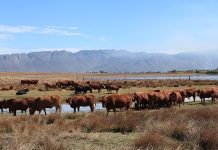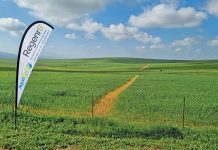The price of wool still has a long way to go to reach the previous record price. The price for fine Merino wool broke through the key R100/kg level recently.
This is still lower than the price of Merino wool during the Korean War of 1950/1951. The US bought the world’s wool for strategic purposes and it reached a price of £1 per pound of wool or about R400/kg in today’s monetary terms.
According to Derick Pape, managing director of Modiano SA, one of the country’s biggest buyers of greasy wool, the current rising demand for wool is less from new users of the fibre and more from low stocks coupled with fading pessimism about the European financial situation.
“The sharp price dip six weeks ago, which had wool growers worried that the market had lost steam, was caused by mills, spinners and weavers holding back orders because of the economic uncertainty in Europe. At the same time, China bought less wool and tried to talk the price down, worried that the high levels would be unsustainable and that further price increases would be difficult to pass on to manufacturers and retailers. But Chinese processors are now active again, hoping for a better Christmas shopping season in Europe,” he said.
Another good sign was the Australian market which rose despite its currency strengthening against the US dollar. “Although Aussie sales are up 9% on last season, offerings are still well below expectations,” Pape noted. “But while we don’t expect or want a sharp hike in the price now – it would be dangerous at this critical stage – we don’t foresee a drastic drop either as the mills simply have to buy wool to keep running.”
Danie Vorster, manager of Merino SA, the official stud breeders’ society, said the good wool prices have stimulated interest in Merinos among irrigation and grain farmers.“The number of Merino rams offered and sold at auctions has steadily increased since 2006. So far this year 3 757 rams have been sold at our 64 auctions, but these figures don’t cover on-the-farm transactions,” he said.
Geoff Kingwill, a wool farmer and chairperson of Cape Wools, noted that the industry faces several challenges although wool prices are helped by the high oil price that affects competing synthetic fibres, a favourable exchange rate for exports, and consumer demand for green and eco-friendly products.
“Today, wool makes up less than 2% of total textile production (synthetics and cotton respectively account for 58% and 36%) and we have to be wary of innovative products from competitors, as well as consumers shopping,” he said. “A drawback is that South Africa is a small player by international standards, producing only 2,3% of global clean wool, even less than Argentina and Uruguay.
‘‘However, it is possible to increase local production by improving production practices and genetics, and expanding the emerging wool growers sector.” Geoff Kingwill, a wool farmer and chairperson of Cape Wools, noted that the industry faces several challenges although wool prices are helped by the high oil price that affects competing synthetic fibres, a favourable exchange rate for exports, and consumer demand for green and eco-friendly products.
“Today, wool makes up less than 2% of total textile production (synthetics and cotton respectively account for 58% and 36%) and we have to be wary of innovative products from competitors, as well as consumers shopping,” he said.
“A drawback is that South Africa is a small player by international standards, producing only 2,3% of global clean wool, even less than Argentina and Uruguay. “However, it is possible to increase local production by improving production practices and genetics, and expanding the emerging wool growers sector.” – Roelof Bezuidenhout
Caption:
The price for fine Merino wool broke through the key R100/kg level recently. This is still lower than the price of Merino wool during the Korean War of 1950/1951.
FW ARCHIVE








